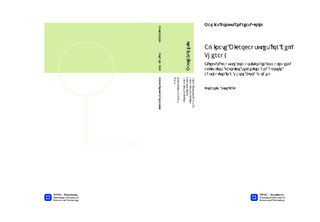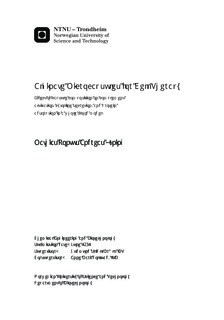| dc.description.abstract | Encapsulation of pancreatic islets in alginate microbeads and microcapsules show great promise for the treatment of Type 1 diabetes mellitus. Significant progress has been made in developing a biocompatible capsule that allows sufficient exchange of nutrients and products with the encapsulated cells, while at the same time maintaining a barrier to immune cells and preventing rejection of the transplanted cells. However, a truly biocompatible capsule has, as yet, not been developed, and implanted capsules often trigger low levels of inflammation leading to fibrosis, diminished insulin secretion, and sometimes death of the encapsulated cells. A lepirudin-based human whole blood model was used to demonstrate the inflammatory potential of a set of different alginate microcapsules and microbeads. This was performed to elucidate the effect of different capsule and bead parameters, such as the effect of a hollow versus solid inner core, polycation type, polycation concentration, alginate type, and capsule and bead diameter. Complement activation after incubation of capsules in whole blood was measured as sTCC generation. In addition, the secretion of chemokines, inflammatory cytokines, antiinflammatory cytokines, and growth factors was analyzed by ELISA and Bio-plex. Leukocyte activation as measured by CD11b expression was detected using flow cytometry. Finally, Confocal Laser Scanning Microscopy (CLSM) was used in order to screen for a set of plasma proteins and observe what proteins adsorbed to the capsule surface. TAM alginate microbeads did not trigger complement activation, secretion of cytokines, or up-regulation of CD11b expression, and thus appeared to have a minimal inflammatory potential. In addition, the protein adsorption assay showed no apparent protein surface deposition on the microbeads after 6 hours of incubation in plasma of the proteins screened for (complement protein C3, complement regulatory proteins factor H, factor I, C1 inhibitor, and vitronectin, as well as coagulation cascade proteins fibrinogen, plasminogen, and HMWK). Solid alginate APA microcapsules containing poly-L-lysine (PLL), on the other hand, showed an increase in complement component sTCC levels, in chemokine levels (IL-8, MCP-1, and MIP- 1α), in inflammatory cytokine levels (IL-6, IL-1β, and TNFα), in anti-inflammatory cytokine levels (IL-1RA and IL-10), and in growth factors levels (PDGF, HGF, and VEGF), as well as a decrease in cytokine IP-10 levels. In addition, the capsules also stimulated leukocyte activation by up-regulating the expression of CD11b. The solid APA micrcapsules showed heavy C3 adsorption, coupled with vitronectin and factor H surface deposition, indicating increased complement activity on these capsules. Hollow APA microcapsules with PLL triggered a rapid and strong sTCC response, as well as significantly increased secretion of the chemokine MCP-1. At the same time, a significant decrease in secretion of chemokines (IL-8 and MIP-1α) and inflammatory cytokines (IL-1β and TNFα), as well as a decrease in secretion of growth factor VEGF, and cytokine MIF, and an increase in cytokine IP-10 was observed. All these cytokine levels except the chemokine MCP- 1 and the complement complex sTCC suggested reduced inflammatory potential for hollow APA capsules. It was proposed that these capsules adsorbed the anaphylatoxins C3a and C5a, thus preventing the complement mediated activation of leukocytes. No increased surface adsorption of C3 was detected on hollow APA capsules compared to solid APA capsules. Conversely, the C3 adsorption was higher on solid APA capsules, thereby not reflecting the increased sTCC generation seen for hollow APA capsules. One explanation for this might be that the hollow capsules secreted some soluble molecule capable of triggering sTCC generation. No apparent change in inflammatory potential could be observed by exchanging the polycation PLL with PLO (poly-L-ornithine), except for abolishing the strong sTCC response observed for hollow APA capsules with PLL as well as lowering the MCP-1 response. It was suggested that this observation could be the result of PLO reducing the permeability of the capsules, thus preventing the diffusion of the hypothesized soluble trigger of sTCC. Increased sTCC was detected with increasing PLL concentration in High G alginate APA capsules. The same could not be observed for High M alginate capsules, however, the chemokine IL-8 and the inflammatory cytokines IL-1β and TNFα increased with increasing PLL concentration, suggesting increased inflammation with increasing PLL concentration. No change in inflammatory potential could be detected with varying alginate microbead diameter. Nor could any change in inflammatory potential be observed by the addition of HEPES in the gelling solution. TAM alginate microbeads appear to have the lowest inflammatory potential of the capsules tested, and are therefore the most suited for in vivo application from an inflammatory aspect, as demonstrated by the whole blood assay. A recent study in Type 1 diabetes patients however showed increased fibrosis when encapsulating human islet cells in barium alginate microbeads [61]. Further studies where incubation of TAM microbeads with isolated monocytes are co-cultured with fibroblasts could further elucidate the mechanisms of fibrosis on the microbeads. In addition, continued screening of protein adsorption on the bead surface should be performed. | nb_NO |

